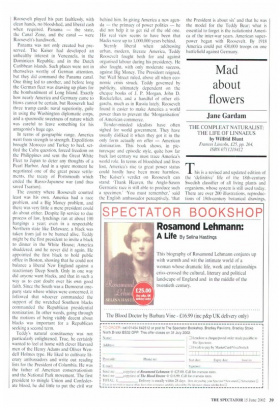Mad about flowers
Jane Gardam
THE COMPLEAT NATURALIST: THE LIFE OF LINNAEUS by Wilfrid Blunt Frances Lincoln. £25, pp. 264, ISBN 0711218412 This is a revised and updated edition of the 'definitive' life of the 18th-century Swedish classifier of all living plants and organisms, whose system is still used today. There are over 200 illustrations, reproductions of 18th-century botanical drawings,
paintings and engravings and contemporary photographs of Sweden — deep meadows, Linnaeus's yellow house, a tiny museum on a knoll in a wood. He is still called 'the Flower King' in Sweden and is a national hero. Photographs of the luminous swamps of Lapland explain why his botanical explorations there were the journeys of his life.
Linnaeus's terminology and botanical Latin are now used in every garden centre. At the Royal Horticultural Society shows it is spoken like a lingua franca — or the old Latin Mass. Linnaeus was not only a classifier but a simplifier, and has bound the natural world together.
An artless-looking man and a religious one (on first seeing a landscape of English flowering furze he fell to his knees and thanked God), he was by no means humble about his achievements. Time has shown he had no need to be. There are delicious events in the book like the botanical picnics to which he invited anyone who cared to come and where he expounded on all they saw and then everyone went home to the music of a band.
Written by Fellows of the Linnaean Society — Blunt was for years also chief drawing master at Eton — and Professor Stearn of the British Museum and Natural History Museum, it is still a book for the common reader. Steam's new appendix on Linnaean classification is a survey of the facts needed to understand his method. The colour is delicate and the book's emblem, which was Linnaeus's, is the exquisite Lapland Linnaea borealis, a plant to die for. The halftitle is also Linnaeus's motto: Tantus amor forum': 'Such a great love of flowers'.



































































 Previous page
Previous page